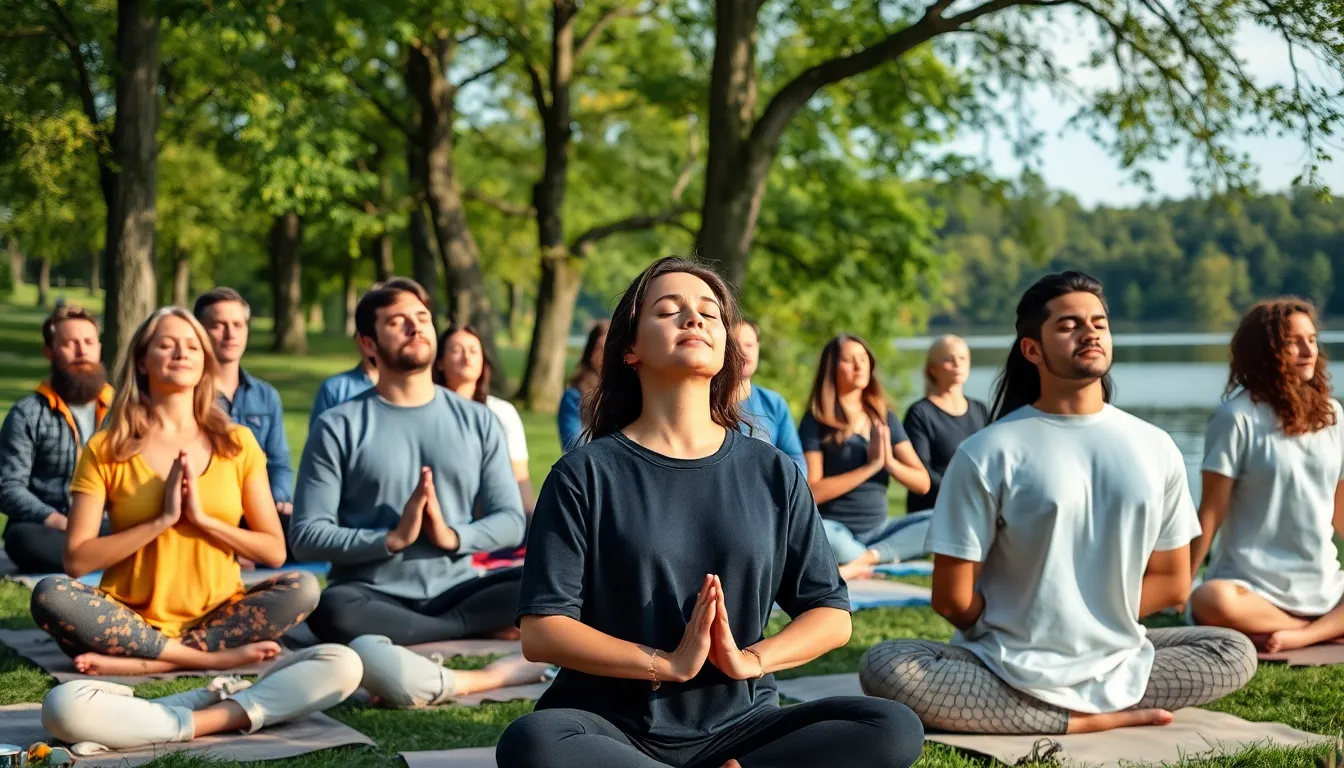In a world that feels like it’s spinning faster than a hamster on a caffeine high, finding a moment of peace can seem impossible. But what if he told you that embracing mindfulness doesn’t require a degree in Zen studies or a month-long retreat in a mountain cave? It’s all about simple practices that can be woven into the chaos of daily life, like slipping a sneaky veggie into a kid’s mac and cheese.
From mindful breathing to savoring that first sip of coffee, these easy techniques can transform stress into serenity in no time. Imagine turning the mundane into moments of magic, all while keeping your sanity intact. So grab a seat, take a deep breath, and discover how these straightforward mindfulness practices can help anyone find their calm amidst the storm.
Table of Contents
ToggleOverview of Easy Mindfulness Practices
Easy mindfulness practices enhance daily life. Practicing mindful breathing takes only a few moments and can provide immediate stress relief. Individuals can focus on their breath, inhaling deeply and exhaling slowly, which calms the mind.
Savoring small moments is another effective technique. Enjoying a cup of coffee offers a chance to notice the aroma and flavor. Engaging the senses creates a richer experience, making even routine activities enjoyable.
Walking mindfully adds another layer to daily routines. Taking walks while paying attention to each step and the surrounding environment fosters a connection with the present moment. Participants can observe nature or their footsteps, enhancing awareness.
Incorporating gratitude into the day also proves beneficial. Listing three things one appreciates each day shifts focus away from negativity. This simple practice cultivates a more positive mindset.
Setting a timer for brief mindfulness breaks responds well to busy schedules. Dedicating five minutes to pause and check in with one’s feelings or thoughts improves overall well-being. Mindfulness apps assist in guiding these moments.
Engaging in mindful listening during conversations fosters deeper connections. Focusing fully on the speaker without distractions enhances understanding. Individuals often find this practice enriches their relationships.
Practitioners can explore body scans as a mindfulness technique. Scanning from head to toe helps individuals tune into physical sensations and release tension. Regular practice encourages relaxation.
These straightforward mindfulness practices provide clarity and calm. Integrating them into daily routines offers sustainable approaches to reducing stress and enhancing peace.
Benefits of Mindfulness

Mindfulness offers numerous advantages, enhancing mental and physical well-being. Practicing mindfulness leads to substantial improvements in overall health.
Mental Health Benefits
Reduced anxiety and depression often result from consistent mindfulness practice. It encourages present-moment awareness, which can lead to decreased worrying about the future. Sharper focus and attention also gain enhancement through mindfulness techniques. Emotional regulation improves, allowing individuals to respond to challenges more calmly. Studies indicate that practicing mindfulness can elevate overall mood, contributing to emotional resilience. Improved self-esteem frequently follows regular engagement in mindfulness activities.
Physical Health Benefits
Stress reduction plays a significant role in the physical health benefits derived from mindfulness. Lower blood pressure results from consistent mindfulness practices such as deep breathing and body scans. Enhanced immune function often occurs with reduced stress levels, promoting better overall health. Better sleep quality frequently accompanies a mindfulness routine, helping to combat insomnia. Research has shown a link between mindfulness and reduced pain perception, allowing individuals to manage discomfort more effectively. Maintaining a healthy lifestyle also benefits from the increased awareness that mindfulness fosters, promoting healthier choices.
Simple Mindfulness Techniques
Mindfulness techniques are easy to integrate into daily life. These practices help enhance mental well-being and promote a calming environment.
Breathing Exercises
Breathing exercises focus on deep inhalations and slow exhalations. inhaling through the nose for a count of four fills the lungs completely. Exhaling through the mouth for a count of six releases tension. Practitioners can repeat this cycle for five minutes to reset their state of mind. While engaged in these exercises, concentrating on the breath fosters awareness and presence. Anxiety decreases, letting individuals feel centered and relaxed.
Body Scanning
Body scanning encourages awareness of physical sensations. This practice involves lying down comfortably and directing attention to each body part. Starting from the toes, individuals can work their way up to the head, noticing areas of tension or discomfort. With each breath, they can consciously relax these areas. This approach promotes a connection between the mind and body, enhancing overall well-being. Regular body scanning enhances awareness of physical states, contributing to emotional regulation.
Mindful Walking
Mindful walking transforms a simple activity into a meditative experience. During this practice, individuals can focus on each step, feeling the ground beneath their feet. Observing the world around them cultivates an enhanced sense of presence. Focusing on surrounding sounds and sights enriches this experience. Engaging in mindful walking also provides an opportunity to connect with nature, which enhances mood and reduces stress. Regular practice of mindful walking cultivates a profound appreciation for everyday life.
Incorporating Mindfulness into Daily Life
Mindfulness enhances daily life through simple adjustments. Practicing it during morning routines, work hours, and evening wind-downs promotes consistent well-being.
Morning Routine Practices
Begin each day with mindfulness through intentional practices. One effective way involves starting with deep breathing exercises, focusing on each breath for a few minutes. Sipping coffee or tea mindfully adds another layer; appreciating flavors and sensations sets a positive tone. Engaging in gentle stretching or yoga promotes physical and mental awareness before daily tasks. Affirmations can also foster a sense of purpose, helping individuals embrace the day with gratitude.
Mindfulness at Work
Mindfulness can improve focus and productivity at work. Setting aside a few minutes for brief breathing exercises throughout the day helps alleviate stress. Engaging fully in conversations during meetings enhances communication and builds stronger connections with colleagues. Using mindful pauses before responding encourages thoughtful reactions rather than impulsive ones. Allocating time for a short walk during breaks promotes clarity and reduces mental fatigue.
Evening Wind Down Techniques
Ending the day with mindfulness fosters relaxation and prepares for restful sleep. Engaging in a reflective journaling practice allows individuals to acknowledge daily experiences and emotions. Creating a calming routine involving gentle stretches or meditation can help release tension accumulated during the day. Limiting screen time and enjoying nature connects individuals to the present moment. Lastly, practicing gratitude by recalling three positive moments reinforces emotional well-being and encourages a peaceful end to the day.
Resources for Further Exploration
Numerous resources exist to deepen understanding and practice of mindfulness. Books provide comprehensive insights, including “The Miracle of Mindfulness” by Thich Nhat Hanh, which introduces core concepts and practices. “Wherever You Go, There You Are” by Jon Kabat-Zinn offers an engaging approach to integrating mindfulness into daily life.
Online courses also enhance knowledge, with platforms like Mindful Schools and Coursera offering structured learning experiences. These platforms often combine video lessons, guided meditations, and community discussions for a holistic learning experience.
Mobile applications facilitate accessible mindfulness practices. Apps such as Headspace and Calm provide guided meditations and reminders for consistent practice. They cater to different levels, making mindfulness available for beginners and seasoned practitioners alike.
YouTube features numerous channels dedicated to mindfulness and meditation. Channels like The Honest Guys and Jason Stephenson provide guided meditations and mindfulness exercises that support daily practice.
Local community centers or yoga studios frequently offer mindfulness workshops. Programs typically include group sessions led by experienced instructors, enhancing understanding through shared experiences.
Podcasts also serve as valuable resources. Shows like “On Being” explore mindfulness alongside philosophy and spirituality, fostering deeper reflections on mindfulness’s benefits.
Websites such as Mindful.org deliver articles, videos, and a plethora of tips on incorporating mindfulness into daily life. These resources help individuals craft personalized mindfulness practices, making it easier to find tranquility in daily routines.
Embracing easy mindfulness practices can significantly enhance daily life. By integrating techniques like mindful breathing and savoring small moments, individuals can transform stress into tranquility. These simple adjustments not only foster a greater sense of awareness but also improve emotional resilience and overall well-being.
The beauty of mindfulness lies in its accessibility. Anyone can incorporate these practices into their routines without the need for extensive training. As individuals begin to experience the benefits of mindfulness, they’ll likely find themselves more present and engaged in their lives. With consistent practice, mindfulness can become a powerful ally in navigating the challenges of a fast-paced world.

